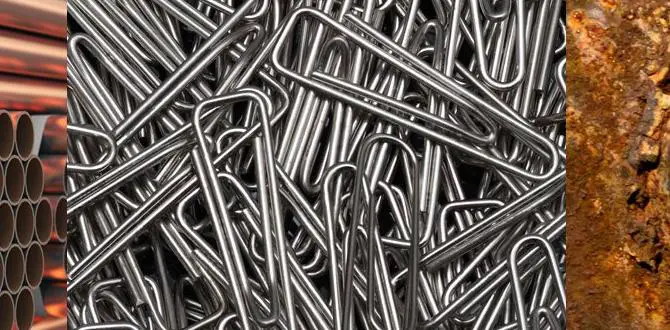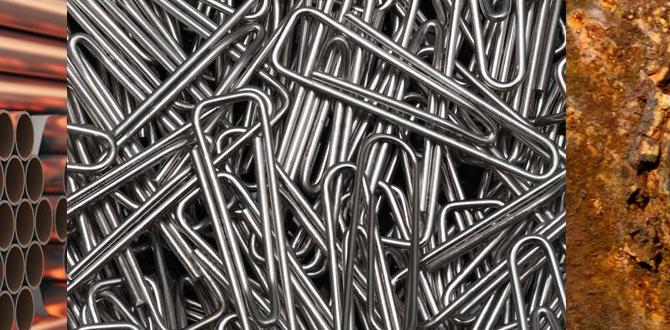To achieve a mirror finish with a carbide end mill, focus on using sharp tools, appropriate speeds and feeds, high-quality coolant, and a clean, rigid setup. Selecting the right carbide end mill for your material, like a specific long-reach 8mm shank model for stainless steel 304, is crucial. Careful machine control and multiple finishing passes will refine the surface to a polished, reflective state.
Welcome to Lathe Hub! We all dream of that perfectly smooth, gleaming surface on our machined parts. It’s not just about aesthetics; a mirror finish can mean improved performance and durability. But getting there, especially with a carbide end mill, can sometimes feel like chasing a ghost. Don’t worry, it’s a common challenge many home machinists and aspiring pros face. With the right techniques and a little patience, you absolutely can transform rough surfaces into dazzling reflections. In this guide, we’ll break down exactly how to achieve that essential mirror finish, step-by-step, making it simple and achievable for anyone working with their milling machine.
Understanding Your Carbide End Mill for Mirror Finishes
Carbide end mills are amazing tools. They’re super hard, which means they can cut tough materials and last a long time. But this hardness also means they can be brittle. When we talk about getting a mirror finish, we’re really talking about making the smallest possible chips with the smoothest possible cut. This minimizes any tiny peaks and valleys left by the cutting edges.
For a mirror finish, you’re aiming for a surface roughness (Ra) that’s incredibly low. Think of it like sanding wood – you start with coarse grits and move to super fine ones. In machining, it’s the same idea, but it’s achieved through the precision of the cutting tool, the machine, and the process.
Why is a Mirror Finish So Desirable?
- Aesthetics: It simply looks fantastic!
- Performance: Reduced friction in moving parts or fluid flow.
- Corrosion Resistance: Smoother surfaces are less prone to rust and chemical attack.
- Dimensional Accuracy: A well-finished surface can be more precisely controlled.
The Importance of the Right Carbide End Mill
Not all carbide end mills are created equal, especially when you’re aiming for a mirror finish. Factors like the number of flutes, the coating, the edge preparation, and even the helix angle play a big role. For instance, if you’re machining challenging materials like 304 stainless steel, you’ll need a specialized end mill. A common requirement for such jobs might be a carbide end mill 3/16 inch 8mm shank long reach for stainless steel 304 mirror finish. This specific description tells us a lot: it’s made of carbide, it has a small diameter (3/16 inch, which is about 4.76mm converting to an 8mm shank, common in small machines), it’s designed to reach into deeper cavities (long reach), and it’s optimized for stainless steel 304, a notoriously gummy metal.
For mirror finishes, you generally want end mills with:
- Fewer Flutes: Typically 2 or 4 flutes. More flutes can chatter and are better for roughing or high-speed finishing of softer materials. Fewer flutes provide more chip clearance and can run at slower, more controlled speeds suitable for fine finishing.
- Polished Flutes: Highly polished flutes help chip evacuation and reduce friction, leading to a smoother cut.
- Sharp, Honed Edges: A perfectly sharp and slightly honed (micro-chamfered) cutting edge is crucial to avoid tearing the material.
- Specific Coatings: Coatings like TiAlN or TiCN can help with heat dissipation and tool life, but for the absolute smoothest finish, sometimes an uncoated, highly polished carbide is preferred, especially in certain materials.
Essential Setup for a Mirror Finish
Before a single cut is made, your setup needs to be rock solid. Imagine trying to paint a masterpiece with a wobbly easel – it’s not going to work. The same applies to achieving a mirror finish on your milling machine.
1. Machine Rigidity is King
Any vibration or flex in your machine will translate directly into a poor surface finish. This means:
- Ensure your milling machine table, vise, and spindle are clean and free of play.
- Tighten all gibs appropriately.
- Avoid using long, unsupported tool holders or extensions if possible. A direct collet chuck is ideal.
2. Workholding Perfection
Your workpiece absolutely must be held securely. Any movement means inconsistency in the cut, and that’s the enemy of a mirror finish.
- Vise Jaw Condition: Use clean, flat vise jaws. Soft jaws can be a lifesaver for delicate finishes or irregular shapes, as they conform to the part.
- Alignment: Ensure the workpiece is perfectly square to the spindle axis, especially if you’re milling a flat surface.
- Clamping Force: Apply enough force to hold the part firmly, but not so much that you distort it.
3. Tool Holder and Spindle Inspection
A worn or damaged tool holder can introduce runout, leading to a poor finish. Similarly, a spindle that doesn’t run true is a major problem.
- Use high-quality collets and collet chucks that are clean and undamaged.
- If you suspect spindle runout, it might be time for a service or a runout test using a dial indicator.
Selecting the Right Speeds and Feeds
This is arguably the MOST critical part of achieving a mirror finish with a carbide end mill. Too fast, too slow, too much feed, or too little feed can all ruin your chances.
Speeds and feeds are often a dance between balancing tool life, chip load (how much material each cutting edge removes), surface finish, and avoiding chatter. For a mirror finish, we are typically looking for lighter chip loads and specific surface speeds.
Surface Speed (SFM/SMM)
This is how fast the cutting edge is moving relative to the workpiece. Carbide likes to run faster than High-Speed Steel (HSS), but for finishing, we often operate in a sweet spot. Factors influencing optimal SFM include:
- The specific grade of carbide
- The material being cut
- Any coatings on the end mill
- Coolant/lubrication used
Feed Rate (IPM/MM/MIN)
This is how fast the workpiece is fed into the cutting tool. For a mirror finish, a light feed rate is generally preferred. This means each pass removes a very small amount of material.
Chip Load (Per Tooth)
This is the thickness of the material being removed by each cutting edge of the end mill. A very small chip load is essential for a mirror finish, as it reduces the force on the edge and minimizes material deformation.
Key Principles for Mirror Finish Speeds & Feeds:
- Err on the side of caution: Start with conservative (lower) speeds and feeds.
- Smoothness over speed: Prioritize a smooth cutting action over fast material removal.
- Listen and observe: Pay attention to the sound of the cut and the chips being produced. A smooth, consistent hum with small, well-formed chips is ideal. Avoid squealing, chattering, or producing powdery chips.
Calculating Speeds and Feeds
While precise calculations can get complex, here’s a simplified approach and where to find reliable data.
The basic formulas are:
- Spindle Speed (RPM) = (SFM 12) / (π Diameter) (for Imperial)
- Spindle Speed (RPM) = (SMM 1000) / (π Diameter) (for Metric)
- Feed Rate (IPM) = RPM Number of Flutes Chip Load per Tooth (for Imperial)
- Feed Rate (MM/MIN) = RPM Number of Flutes Chip Load per Tooth (for Metric)
Where to Find Reliable Data:
- Tool Manufacturer Catalogs: These are gold standards. Look for “finishing” speeds and feeds.
- Online Calculators: Many reputable machining supply companies offer free calculators on their websites. A good example is the calculator from Iscar, a well-known cutting tool manufacturer.
- Machinist’s Handbook: The ultimate reference, though it can be dense for beginners.
Example: Finishing 304 Stainless Steel
Let’s say you have a 3/16″ (0.1875″) 2-flute carbide end mill for a carbide end mill 3/16 inch 8mm shank long reach for stainless steel 304 mirror finish application. For 304 stainless, a common starting point for finishing might be:
- Surface Speed: 250-350 SFM
- Chip Load per Tooth: 0.0005″ – 0.001″
Using a conservative value of 250 SFM and a chip load of 0.0007″:
- Diameter: 0.1875 inches
- Flutes: 2
- SFM: 250
- Chip Load: 0.0007 inches
- Spindle Speed (RPM): (250 12) / (3.14159 0.1875) ≈ 5093 RPM
- Feed Rate (IPM): 5093 2 0.0007 ≈ 7.1 IPM
These are starting points. You’d adjust based on your machine’s stability and the actual results. For instance, a long-reach end mill might require slightly slower speeds and feeds due to increased tool deflection.
Tooling Strategies for the Perfect Finish
Achieving a mirror finish isn’t usually a one-pass operation. It often involves a series of careful cuts, each refining the surface from the previous one.
1. Roughing Pass (If Necessary)
If you’re starting from a significantly rough surface, a dedicated roughing end mill or a standard end mill at higher chiploads can quickly remove the bulk of the material. The goal here is to get close to the final dimension efficiently. Leave a small amount of material – the “stock to leave” – for the finishing pass.
2. Semi-Finishing Pass
This pass refines the surface after roughing. Use a clean end mill (or a dedicated finishing end mill if you have one) and reduce the depth of cut significantly. This pass essentially prepares the surface for the final, critical mirror finish pass.
3. Finishing Pass (The Mirror Pass)
This is where the magic happens. For the mirror finish pass:
- Very Shallow DOC (Depth of Cut): Aim for a depth of cut that is only a fraction of the end mill’s diameter, often as little as 0.001″ to 0.005″ (0.025mm to 0.12mm).
- Appropriate Feed Rate: Use the calculated finishing feed rate for a light, consistent cut.
- Optimized Spindle Speed: Ensure your spindle speed is set correctly for the desired surface finish.
- Climb Milling vs. Conventional Milling: For finishing, climb milling (where the cutter rotates in the same direction as the feed) is generally preferred. It creates a smoother finish because it engages the material at the top of the cut and rolls into it, thus reducing tool pressure and potential for chatter. However, it requires a machine with minimal backlash. If your machine has significant backlash, conventional milling might be more stable.
4. Multiple Finishing Passes
Sometimes, one finishing pass isn’t enough. Running a second or even third finishing pass with the same parameters can help blend any micro-imperfections and achieve that ultimate mirror effect. Ensure the tool retracts cleanly and re-engages at the same settings.
5. Tool Engagement Strategy
- Peripheral Finishing: For a flat surface, you’ll typically traverse the end mill across the entire width.
- Stepover: The amount the end mill overlaps on each pass. For a mirror finish, a small stepover (e.g., 20-50% of the tool diameter) is crucial. It ensures that the scallops left by the previous pass are almost entirely removed by the next. A smaller stepover means more passes but a smoother outcome.
- Leading In/Out: When entering and exiting the material, use shallow, arched toolpaths or ramp moves instead of plunging straight down to avoid tool breakage and leave a cleaner edge.
Coolant and Lubrication: Your Silent Partner
Cutting fluids are not just for cooling; they are vital for lubrication and chip evacuation, all of which contribute significantly to a good surface finish. For a mirror finish, especially on tough materials like stainless steel, proper coolant is non-negotiable.
Types of Coolant/Lubrication:
- Flood Coolant: A high volume of liquid coolant. Excellent for general machining and keeping temperatures down.
- Mist Coolant (MQL – Minimum Quantity Lubrication): A fine spray of coolant and air. Good for lubrication and chip blowing, often used in finishing operations to avoid flooding the entire setup.
- Neat Oils/Lubricants: Concentrated cutting oils that provide superior lubrication, especially for aluminum and stainless steel. These are often applied manually or via an MQL system.
- Cutting Paste/Wax: Can be very effective for specific operations like tapping or reaming, and can also be used sparingly with end mills for a mirror finish, particularly on stainless steels.
Why it Matters for Mirror Finishes:
- Reduces Friction: Less friction means less heat and less tendency for the material to “gum up” on the cutting edge.
- Lubricates the Cut: Allows the cutting edge to glide more smoothly over the material, reducing tearing and improving finish.
- Flushes Chips Away: Efficient chip evacuation prevents chips from being re-cut, which degrades the surface.
- Keeps Tool Sharp: Cooler tools maintain their sharpness longer, which is essential for a consistent finish.
For achieving a mirror finish on 304 stainless steel with a carbide end mill, consider using a high-quality synthetic coolant or a specialized cutting paste designed for stainless steel. Ensure your coolant system is delivering the fluid effectively to the cutting zone.
Troubleshooting Common Mirror Finish Problems
Even with the best setup, things can go wrong. Here’s how to tackle common issues:
1. Scallops or Tool Marks
Cause: Chatter, insufficient stepover, or too large a depth of cut.
Solution:
- Increase rigidity (machine, workholding, tool holder).
- Decrease depth of cut and/or feed rate.
- Ensure a tighter stepover.
- Consider climb milling if backlash allows.
- Check for tool wear or chipping.
- Ensure coolant is reaching the cutting zone effectively.
2. Dull or Gummy Finish
Cause: Material welding to the tool edge, insufficient lubrication, incorrect speeds/feeds, tool wear.
Solution:
- Use a sharp, high-quality end mill.
- Increase coolant/lubrication. Consider a paste or MQL.
- Adjust speeds and feeds to achieve a proper chip load. For gummy materials like stainless steel, sometimes slightly higher speeds can help “shearing” the chip rather than deforming it.
- Clean the end mill frequently.
3. Chatter or Vibration
Cause: Looseness in the machine (spindle, bearings, gibs), improper workholding, worn tooling, excessive overhang, incorrect speeds/feeds.
Solution:
- Tighten everything: gibs, tool holder, workpiece.
- Use the shortest possible tool extension.
- Adjust spindle speed (sometimes a slightly higher or lower speed can move out of a resonant frequency).
- Ensure tool is sharp and free of built-up edge.
- Experiment with different depths of cut.
4. Surface is Shiny but Not “Mirror” Smooth
Cause: Still too much material left from previous operations, or






